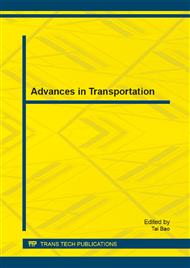p.1084
p.1089
p.1093
p.1097
p.1102
p.1107
p.1114
p.1118
p.1122
The Microscopic Simulation Based on Conflict of Pedestrian Crossing Street
Abstract:
Data was gathered in order to obtain the conflict index at signal intersection when pedestrians crossed the street, and SOMK algorithm was applied to the four indexes of clustering, then index can be applied to evaluate the risk degree of signal intersection after index selection. A signal intersection was selected which was a main-secondary road intersection to simulate with VISSIM. On the basis of quantitating the pedestrian-vehicle conflict at signal intersection, calculated weighted average of the every conflict risk degree in the peak hours at the intersection, then resulted in intersection safety score of pedestrians crossing in peak hours, and evaluated safety grade according to the score. Compared and analyzed the results of actual investigation and simulation, which ensure the simulation model is effective. Afterwards the simulation can be taken into practical application based on its effectiveness.
Info:
Periodical:
Pages:
1102-1106
Citation:
Online since:
January 2014
Authors:
Keywords:
Price:
Сopyright:
© 2014 Trans Tech Publications Ltd. All Rights Reserved
Share:
Citation:


